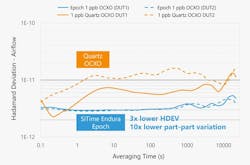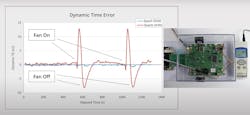New ruggedized timing technology addresses the challenges of GPS-synchronized defense equipment
By Odile Ronat, Product Marketing Director, Aerospace and Defense, SiTime
SANTA CLARA, Calif. - A new generation of oven-controlled oscillators (OCXOs) based on microelectromechanical systems (MEMS) technology is redefining precision timing technology for defense applications. Ruggedized silicon MEMS-based OCXOs can enhance the robustness and resiliency of critical systems for aerospace and defense, such as positioning, navigation and timing (PNT) equipment, by providing an ultra-stable, trustworthy local clock source in PNT systems when global positioning satellite (GPS) signals are disrupted.
Vulnerabilities of GPS-Synchronized Defense Equipment
GPS is widely used as the time reference across defense equipment. GPS signals may not be available or trusted due to inclement weather or other environmental factors or due to spoofing and jamming by adversaries. GPS signal interferences have been widely reported in military theaters including, most recently, Ukraine. Timing devices such as OCXOs provide the framework for real-time communications, networking, armed forces coordination, positioning, navigation, and threat detection. Having a reliable, resilient, and stable local clock is essential for defense operations. Inaccurate timing can have disastrous impacts on military operations in the space, air, maritime, ground, and cyber domains, causing equipment malfunctions, increased risk to personnel, or even complete mission failure. The US Department of Defense (DoD) has made it a strategic priority to develop new systems that are hardened against jamming and spoofing attacks or that can provide trustworthy timing using alternative technologies.
GPS is the source of synchronized time distribution across a wide range of equipment and personnel, including command and control centers, ships, aircrafts, ground vehicles and soldiers. Precision timing in defense equipment is achieved by synchronizing the local clock to the GPS reference clock. When a GPS signal is disrupted, the system must rely on the stability of the local clock. Unless specifically designed to remain stable for minutes to hours, the local clock can drift due to intrinsic noise, aging, temperature, temperature changes, vibration, and other environmental factors. This drift is mitigated by synchronization to GPS in traditional systems. Next-generation GPS systems must address GPS signal vulnerabilities, and a stable clock is essential in these systems to support continued operation during GPS disruptions.
System designers are turning to OCXOs for precision timing in PNT applications. However, traditional quartz-based OCXOs are prone to failure due to their complex construction and face challenges in harsh defense environments. Stressors like vibration, shock, and temperature fluctuations impact their reliability and performance, posing a substantial risk in critical applications. Furthermore, there is a limited selection of commercially available OCXO rated for acceleration sensitivity (g-sensitivity), and they are often pricey, with long lead times.
A new generation of MEMS-based OCXOs, such as SiTime’s Endura Epoch OCXO platform, is designed to overcome the limitations of traditional quartz OCXOs. These MEMS OCXOs are specifically ruggedized for the demanding environments of aerospace and defense applications, especially systems that synchronize to GPS. Silicon MEMS technology leverages high-purity semiconductor processes for unmatched quality and reliability. Manufacturing is managed according to statistical process control and six sigma specifications to deliver part-to-part consistency that customers require to predict system performance in the field with confidence.
A MEMS resonator is about 3000x smaller than a typical quartz resonator, is made of high-strength silicon material, and is encapsulated in an ultra-clean, low-pressure cavity, eliminating contaminations that cause frequency jumps, aging, or failure. The small weight and material strength of the MEMS resonator enable shock and vibration-resistant OCXO designs that are difficult to achieve with traditional quartz OCXOs without compromising on other performance metrics. Silicon MEMS OCXOs can be trusted in high-vibration missions due to their remarkable g-sensitivity of 0.01 ppb/g.
Advantages of MEMS-based OCXOs over Quartz
MEMS-based OCXOs represent a significant advancement over traditional quartz-based counterparts, offering improvements in size, weight, power (SWaP), and reliability. Conventional quartz-based OCXOs, although widely used, compromise frequency stability for environmental ruggedness, consuming substantial power and exhibiting inconsistent performance. Their bulky and complex construction further complicates product design.
In contrast, MEMS-based OCXOs, such as the SiTime Endura Epoch OCXO platform, effectively address these limitations. They surpass quartz counterparts in stability, reliability, and performance under vibration. They boast low phase noise and jitter, essential for high-quality signal transmission, and provide a resilient, high-performance alternative in a compact, low-profile package. Their performance under vibration exceeds most military requirements, eliminating the need for bulky, complex vibration compensation.
Overall, MEMS-based OCXOs are better suited for integration into advanced PNT designs compared to low-g sensitivity quartz devices. They are 30x more reliable, 25x smaller, 2x lower power, 8x more consistent, and offer 70x better acceleration sensitivity. Leveraging silicon MEMS manufacturing and semiconductor supply chain efficiencies, MEMS-based OXCO platforms are readily available with short lead times (10 to 12 weeks once released into production) than quartz OCXOs. Their unique programmability (frequency, voltage, etc.) also eliminates the need for custom design with custom qualification.
Ultra-Stable Timing During GPS Disruption
During GPS disruption, PNT performance is driven by the stability of the local clock without GPS synchronization. The time during which the local clock is not synchronized to the reference clock is referred to as holdover, and the performance for the local clock during holdover is measured as a time error, which is the integration of the frequency drift during the holdover period. When time error becomes too large, system performance rapidly degrades or fails. With time error of only 3 µs over 24 hours without age compensation, a MEMS-based OCXO can extend the PNT performance during GPS disruption over a quartz OCXO. This time error is achieved due to low 5E-12 Allan deviation (ADEV) and low aging of 0.1 ppb/day, specifications that are not achieved in this class of + 1 ppb quartz OCXO. The Hadamard Deviation, which is the ADEV without aging, shows the performance below 5E-12 through 1000s and beyond. It can be further improved with aging compensation performed through the digital frequency pull of the device, which has a ±800 ppm frequency tuning with 5e-14 resolution, lower than the ADEV.
This exceptional holdover performance is attributed to silicon MEMS technology and innovative advancements in MEMS-based OCXO platform design. The platform uses advanced MEMS technology designed for low ADEV. MEMS technology has proven to offer low aging compared to quartz devices due to the purity of the material and low contamination of the MEMS enclosure.
The MEMS OCXO platform developed by SiTime uses proprietary DualMEMS technology, which combines a TempFlat MEMS resonator and a TempSense MEMS temperature sensor on the same die. While the TempFlat resonator is optimized for an ultra-low temperature coefficient in regard to frequency, the TempSense sensor is optimized for temperature sensing. The difference in frequency between the two MEMS resonators collocated on the same die provides an extremely accurate reading of the frequency in the order of 30 micro-Kelvin and allows very accurate heater control and fast temperature compensation. Proprietary mixed-signal circuits can be optimized to provide the tight controls needed for maximum stability with excellent immunity to external noise.
The fast temperature compensation maintains the holdover performance under temperature transients; the frequency stability is virtually unchanged when the oscillator is exposed to fast temperature transients simulated by a 3 m/s airflow.
Selecting Endura Epoch OCXOs to Deliver SWaP Advantages
MEMS-based OCXOs are available in compact surface-mount packages (as small as 9 mm x 7 mm x 3.6 mm3), which are designed to be reflowed with other components on the board. With a small size, low weight of 0.35 g and without the need for vibration compensation, a MEMS OCXO device can save up to 100 g compared to a quartz OCXO. A MEMS-based OCXO also provides flexibility in board layout due to its small size, low power requirement, low sensitivity to vibrations, temperature transient or EMI that can be experienced closed to power supplies or high-power ASIC. MEMS-based OCXOs are factory programmable (typically over a frequency range of 10 to 220 MHz), eliminating long lead times for custom frequencies and simplifying qualification.
Related: Rugged computing for the military stands up to heat, shock, and vibration
The high frequency stability of MEMS-based OCXOs provides enhanced field confidence by maintaining unwavering satellite lock throughout the entire mission. They offer predictable system performance over temperature, under fast temperature changes, under vibrations, and over aging. MEMS-based OCXOs are easy to design into PNT systems due to their reliable performance, eliminating challenges associated with designing and qualifying quartz-based OCXOs while delivering best-in-class frequency stability and low phase noise. By combining high frequency stability over temperature and low phase noise into a single MEMS-based device, these OCXOs enable designers to use an all-in-one precision timing solution for time synchronization and RF signal processing.
A Leap in Precision Timing Technology Innovation for Aerospace and Defense
MEMS-based precision timing devices, as exemplified by SiTime’s Endura Epoch OCXOs, are rapidly innovating and providing a leap in timing technology for aerospace and defense applications. Next-generation MEMS OCXOs address critical weaknesses in military PNT systems, offering ultra-stable clock references crucial for national security. The manufacturing advantages of silicon MEMS technology result in precision timing products that are highly reproducible and scalable. This innovative manufacturing approach eliminates timing device vulnerabilities in demanding sectors like aerospace and defense, where failure is not an option.
MEMS-based OCXOs stand out for their ability to enhance SWaP performance in emerging PNT systems and provide reliable clock references for GPS. Their superior construction and performance under challenging conditions make these OCXOs an indispensable tool for national defense and security, ensuring operational excellence and resilience in the face of evolving global threats.
For more information about SiTime’s Endura Epoch OCXOs, visit https://www.sitime.com/endura-epoch-platform-ocxo.


